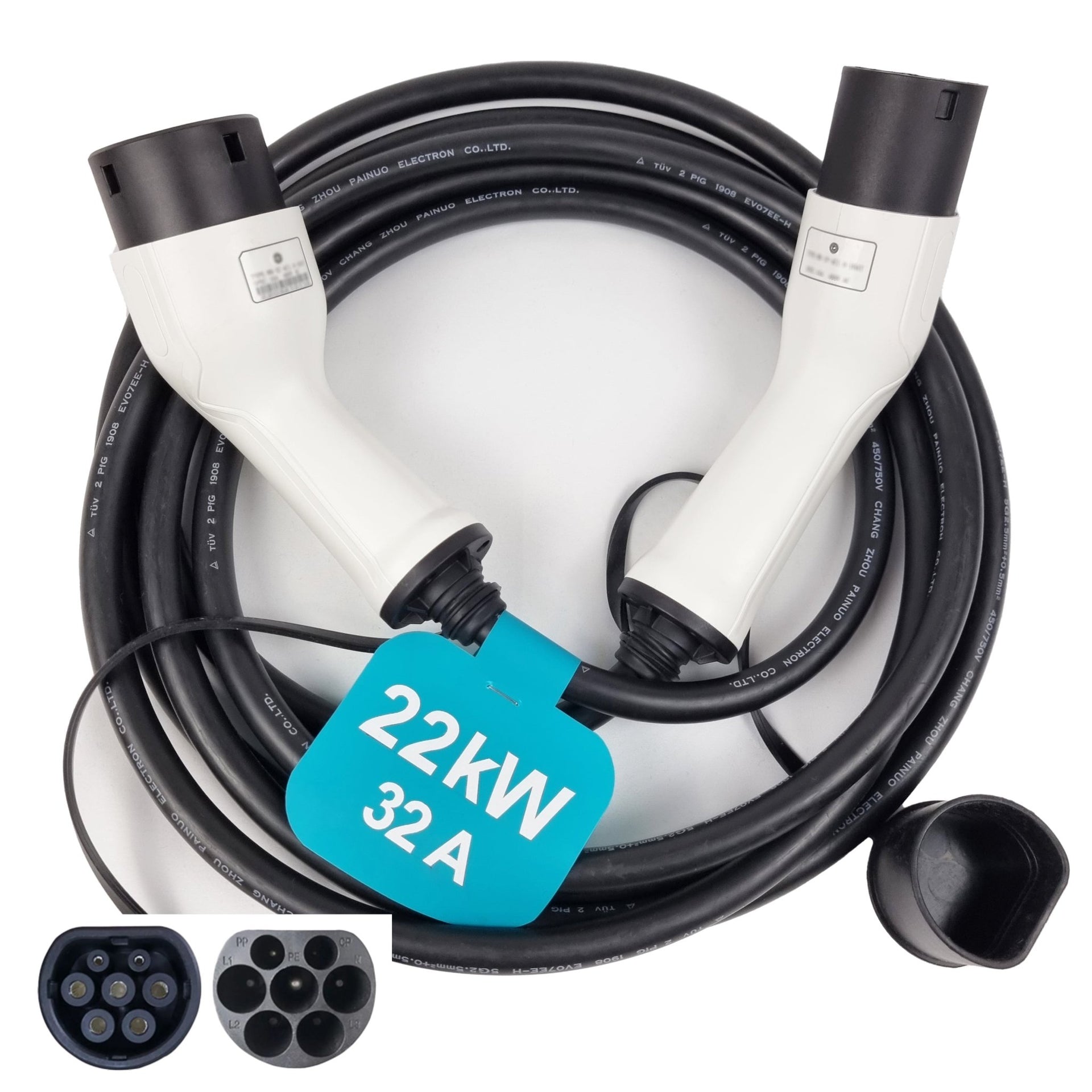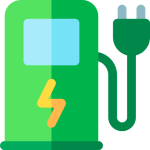
In the world of electric vehicles, the cable is the vital lifeline connecting your battery to the power source.1 For new owners, the terminology—Type 2 cable, CCS2, Mennekes—can feel like a confusing alphabet soup. However, understanding your EV charger cables Australia standards is non-negotiable for smooth daily driving and stress-free road trips.
This guide from EV Evolution breaks down the essential cable types, highlights the critical necessity of carrying your own cable, and ensures you’re always prepared to plug in anywhere on the continent.
The Standard Bearer: Decoding the Type 2 Cable
The Type 2 cable, often known by its original European name “Mennekes,” has cemented its place as the Australian standard for AC (slow to medium) charging.2 If you own a modern EV from brands like Tesla, Hyundai, Polestar, MG, or BMW, your vehicle will have a Type 2 inlet.3
What is a Type 2 Cable?
A Type 2 connector is a 7-pin oval-shaped plug designed to handle both single-phase (up to 7.4 kW) and three-phase (up to 22 kW) Alternating Current (AC).4
| Feature | Importance for Australian EV Owners |
| AC Compatibility | It’s the universal plug for all Level 2 home wall chargers and public AC stations. |
| Three-Phase Ready | Allows your vehicle to take advantage of faster 22 kW charging if available on the grid or in public car parks. |
| Automatic Locking | The plug electronically locks to the charging port when charging starts, preventing theft and disconnection—a vital safety feature in public areas. |
The Critical Need for a “Bring Your Own Cable” (BYO) Solution
This is where many new EV owners get caught out: Most Level 2 public AC charging points in Australia do not have a cable attached.5
Imagine pulling up to a public AC charging bay at a shopping centre or parking garage, only to find it has a socket (also called an ‘untethered’ or ‘socketed’ charger) rather than a permanently attached cable.6 If you don’t have your own portable Type 2 cable (specifically, a Type 2 to Type 2 cable), you can’t charge.7
Why the BYO System?
- Flexibility: It allows any compatible EV (whether single- or three-phase) to use the socket.8
- Maintenance: It reduces wear and tear on the public charging station hardware.
- Security: It means the charging station itself is less vulnerable to cable vandalism or theft.9
Conclusion: A high-quality, weather-resistant Type 2 to Type 2 cable is not an accessory; it is an essential piece of roadside kit for any Australian EV owner planning to use public charging infrastructure. You should have at least a 5-meter version stored neatly in your boot.
⚡ Beyond AC: Understanding CCS2 for Fast Charging
While the Type 2 plug handles all your AC charging, a separate, more robust connector is required for high-speed DC charging: the Combined Charging System 2, or CCS2.10
CCS2: The DC Fast-Charging Standard
The CCS2 connector literally combines the standard Type 2 AC inlet pins with two large, additional DC pins underneath.11
- AC Compatibility: When you plug a standard Type 2 cable into a CCS2 vehicle inlet, the upper pins are used for Level 2 AC charging (the bottom pins remain untouched).12
- DC Compatibility: When you use a DC fast-charging station, the large CCS2 plug uses all seven pins (plus the two large DC pins) to deliver massive amounts of power (50 kW, 150 kW, 350 kW) directly to the battery.13
Do you need to buy a CCS2 cable?
No. All Level 3 (DC) fast-charging stations across Australia—whether they are Chargefox, Evie Networks, or Tesla Superchargers (now open to other CCS2 vehicles)—have the thick, heavy CCS2 cables permanently attached (or ‘tethered’).14 This is because the high-powered cable itself is an integral, safety-monitored part of the charging station unit.
The key takeaway is that your car must be compatible with a CCS2 inlet to use the fastest public chargers, but you do not need to carry a CCS2 cable. You only need to carry your Type 2 to Type 2 AC cable.
🛡️ Beyond the Plug: Cable Quality and Safety in Australia
When investing in an EV charger cable Australia-wide, the quality and safety features are arguably more important than the length or colour. A subpar cable is not just a charging risk; it’s a fire risk.
1. AS/NZS Standards and Safety
Always choose cables that adhere to Australian and New Zealand safety standards. Look for:
- IP Rating: An Ingress Protection (IP) rating of IP54 or higher is essential.15 This guarantees the cable is protected against dust and water spray, making it safe to use outdoors in an Australian downpour or under high humidity.
- Thermal Protection: Quality cables feature integrated temperature sensors that communicate with the car and the charger. If the cable or the plug gets too hot—a risk when charging at high currents in the Australian summer heat—the charging rate will automatically slow down or stop, preventing overheating.
- Durable Sheathing: The outer layer should be made of industrial-grade materials like Thermoplastic Polyurethane (TPU).16 This keeps the cable flexible even in cold conditions and resistant to abrasion from being dragged across concrete and asphalt.
2. Single-Phase vs. Three-Phase Cables
Your portable cable needs to match your charging needs:
- Single-Phase (7.4 kW): This cable is perfect for single-phase home wall chargers (the most common type) and will handle the majority of public AC charging at up to 7.4 kW.17
- Three-Phase (22 kW): This is the ultimate Type 2 cable investment.18 While your home might not have three-phase power, many public AC charging stations do.19 A 22 kW cable allows compatible vehicles to charge three times faster (e.g., 22 kW instead of 7.4 kW) when you find a three-phase public charger, making it ideal for those who road trip or rely on public charging frequently.
🧳 Your Essential Charging Cable Checklist
To conquer range anxiety in Australia, you should aim to own two types of cables/chargers:
| Essential Item | Purpose |
| 1. Portable/Emergency Charger (Mode 2) | Plugs into a standard 10A or 15A wall socket. Used for slow trickle charging when nothing else is available (e.g., at a friend’s house or holiday accommodation). |
| 2. Type 2 to Type 2 Cable (Mode 3) | Your must-have BYO cable for public AC charging stations that are untethered. A 22 kW-rated cable is the best investment for future-proofing and maximum public charging speed. |
Do not leave home without your Type 2 to Type 2 cable! It is your passport to accessing a vast and growing network of public AC charging points that rely on the BYO standard.20
🛒 Choose Safety and Reliability: Shop EVolution Portable Cables
Having a reliable, certified, and appropriately rated portable charging cable ready in your boot is the definition of smart EV ownership. At EV Evolution, we stock only Australian-compliant cables featuring thermal protection and durable IP-rated construction, designed to withstand the harsh Aussie climate.
Future-proof your driving experience today. Shop our range of portable Type 2 to Type 2 charging cables and adapters.
FAQs
Do I need to carry a CCS2 cable in my car?
No. DC fast chargers (Level 3) in Australia generally have tethered CCS2 cables attached to the station. What you do need to carry is a Type 2-to-Type 2 cable for untethered public AC chargers.
What length Type 2 cable should I buy?
A 5-metre cable strikes a good balance between reach and storage. If you often face awkward parking situations, consider 7 m. Avoid unnecessarily long cables that add weight and storage complexity.
Is a cheap cable OK if it looks the same?
Don’t risk it. Cheap, uncertified cables may lack thermal cut-outs, proper insulation and required safety approvals. Choose cables from reputable suppliers that provide Australian compliance documentation.
Will a three-phase Type 2 cable charge my car faster at home?
Only if your home supply and wallcharger are three-phase, and your car supports three-phase charging. In most suburban homes you’ll have single-phase supply; three-phase cables are most useful for public AC chargers that can deliver 22 kW+.
How should I care for and store my cable to keep it safe?
Keep it in a protective bag in the boot, avoid dragging across rough surfaces, do not coil tightly while the cable or connector is hot, and inspect periodically for damage. If the cable gets wet, allow it to dry fully before the next use and check connectors for corrosion.
Can I use a standard domestic power point in an emergency?
Yes, with a certified portable Mode 2 EVSE that is compatible with domestic sockets, but be aware charging will be slow and must be done on a dedicated circuit without extension leads. For safety and to protect electrical infrastructure, consult an electrician if you intend to charge regularly at home.
About EV Evolution
EV Evolution is the leading online platform dedicated to Australian electric vehicle owners and enthusiasts. We foster a vibrant community, delivering essential EV news and insights, and enhancing user engagement through our innovative, AI-powered chatbot for dynamic discussions. Our mission is to empower Australian electric vehicle owners and enthusiasts by fostering a vibrant, AI-driven online community that connects, informs, and advances the nation’s electric vehicle landscape.




